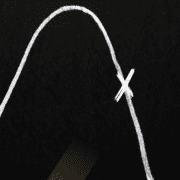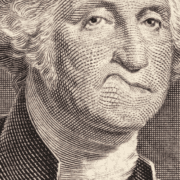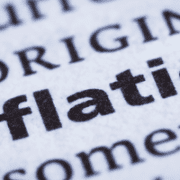Should the Gold Price Keep Up with Inflation?
The popular belief is that gold is a good hedge against inflation. Owning gold will protect you from rising prices. Is that true?
Most people define inflation as rising prices. Economists will quibble and say technically it’s the increase in the quantity of money, however Milton Friedman expressed the popular belief well. He said, “Inflation is always and everywhere a monetary phenomenon.”
There you have it. The Federal Reserve increases the money supply and that, in turn, causes an increase in the price of everything, including gold. It’s as simple as that, right?
Except, it doesn’t work that way. Just ask anyone who has been betting on rising commodities prices since 2011. Certainly the money supply has increased. M1 was $1.86T in January 2011, and in March it hit $3.15T. This is a 69 percent increase. However, commodities have gone the opposite way. For example, wheat peaked at $9.35 per bushel in July 2012, and so far it’s down to $4.64 or about 50 percent. And the price of gold fell from $1900 in 2011, to $1050 late last year, or 45 percent.
Would you say that inflation is +69%, or is it -45% or -50%?
Most people look at retail prices, not raw commodities or gold. Retail prices have not followed into the abyss. Love it or hate it, the Consumer Price Index registers a cumulative 8 percent gain from 2011 through 2015 inclusive.
Let’s consider an example to help understand why. Suppose you own a coffee shop in a central business district. The city enacts a new regulation that limits the hours for delivery trucks. This forces you to pay overtime wages to your staff to unload the trucks, and of course, the carrier charges more for delivery too.
Next, the city allows poor people to stop paying their water bill. So to compensate, they raise the water rates on businesses. While they’re at it, they raise the fees for sewer, garbage, gas line hookups, fire inspections, and sign permits. The state passes a higher minimum wage law. The building inspector requires that you increase the size of your bathroom to accommodate wheelchairs, and you lose revenue-generating floor space. There are hundreds of ways that government increases your costs.
Is this inflation?
Not yet, costs are up but not prices. Sooner or later, all of the affected coffee shops try raising their prices. Consumers don’t necessarily want to pay more for coffee, so a few shops fail. The survivors are now charging 15% more for coffee. They have their higher prices, at the cost of lower sales volume.
The burden of government bearing down on the coffee business only increases. Every day, three constituencies conspire to drive up costs. We’ll call them the “there oughtta be a law” crowd, the “government needs more revenues” mob, and the “they served 10oz of coffee plus 4oz of ice so let’s sue them” racket.
Regulation, taxation, and litigation drive up price. Friedman was wrong. The rising price of lattes is not a monetary phenomenon (the monetary system is pressuring prices lower right now, and in my theory of interest and prices I discuss why). Rising retail prices are a fiscal, regulatory, and judicial problem.
There is no reason for the price of gold to follow retail, because there is no mechanism that connects gold to these non-monetary costs.








Keith,
Your points are valid but somewhat narrow. There is a much more general principle, relating to production and demand. Anyone who has lived in a rapidly developing country has experienced strong inflation, and anyone who has been through a ghost town has witnessed severe deflation.
The issue here is that production does not align quickly with changes in demand, resulting in either shortages or flooding of the market, in whatever sector is experiencing the changes in demand. This can’t be resolved quickly with “adjustments”, the only regulating mechanism that is immediately appearing is inflation/deflation, with or without government interventions.
Symmetrically, significant changes in production (new plant coming on line, old plant shut-down) will dramatically affect the supply into the market, also causing rapid and durable fluctuations in price levels.
All this is particularly sensitive when the changes are big in % compared to the overall market, and less so when the % is small.
Bravo Keith and virgule, very well said. Both posts are common sense explanations of “inflation”.
Deflation is the natural state of affairs as productivity and technological advances drive down costs. The late 19th century in America exemplifies this reality. Modern democratic governments are increasingly irresponsible, seeking new ways to create inflation, primarily to bail out debtors, most notably the governments themselves, despite their protestations regarding employment, social justice, etc. The last firewall is fiscal policy, not yet fully utilized to achieve their ends.
Japan is demographically challenged, an insular old age colony with a declining population. What fails to “succeed” there is not necessarily a precedent. Germany remains a European firewall of sorts. A Republican congress in the U.S. remains another firewall of sorts. No government is willing to seriously address structural reforms; Germany was the last country to do so.
Likely we can muddle along for some time. Yet this reality reminds me of the question “How did you go bankrupt?” Answer “Two ways, gradually then suddenly”.
Actually, I believe we will default by debasing fiat money, gradually at times, more rapidly at other times, but inexorably. Gold, silver, and platinum are insurance policies, sometimes costly, sometimes reasonably priced.
Don’t understand where your argument is taking us: of course prices are sticky and supply/demand imbalances may take years to play out. What does that have to do with the money supply or the nexus between extraneous costs, interest, inflation, and gold?
Good read. T/y.
You’ve got a good point Keith. That rings true for my neighborhood.
I must point out that it is virgule who perhaps has the narrower point. He did not make an argument for the current situation being in a supply/demand imbalance. In fact, if we take into account the diminishing consumer demand (lower paying jobs, savings increasing, uncertainty regarding the future, etc.), retail prices should be dropping. The US is not a rapidly developing country.
$204 Premium, gold over platinum … down from almost $300. What’s up?
Mr. Market is discovering that platinum is inexpensive compared to gold, at last. Gold is a better value given a reserve currency collapse; otherwise platinum is a lower cost insurance policy for one’s accumulated wealth. I don’t expect this trend to reverse directions (other than normal market fluctuations) any time soon.
Good essay, Keith, but Friedman’s claim about “monetary phenomenon” is out of context in your example. If there were NO change in the “money supply” then the rising regulatory costs would do everything you described, and coffee prices would go up due to fewer competitive outlets for coffee. Due to rising costs; but the demand for coffee is unchanged, only the quantity demanded is changed.
Consumers remaining in the market after higher coffee prices are charged would be “pushed up along their demand curve” moving to the smaller quantity that can be produced given the regulations. It is on the Supply Side that the constriction in quantity occurs. There would be “no change in the average level of all prices” as the unspent money of the disappeared coffee-buyers will be spent on other goods.
That “redistribution of spending, instead of price-inflation” is not the case, necessarily, when the “money supply” is “elastic” as was the purpose of the Federal Reserve Act. Friedman’s quote was criticizing the Fed. But this does not address your main question – why no explosion in the price of gold?
What is most interesting today is that the “money supply” is UNLIMITED. If we define M1 in regular terms, circulating currency and demand deposits, we miss most of that big number you cited, $3.15T. Most of it is INSIDE the Fed’s balance sheet (“reserves”) and the Fed pays banks interest to hold them, just as the Fed receives government-paid interest income on its Treasury bond inventory.
So, the big question that professional economists CANNOT ANSWER today is why the commodity prices are so low, given the large supply of “dollars”? You did not address that question. Instead you just blamed Milton Friedman for explaining to you why the retail price of coffee might go up – WHEN people have sufficient funds to keep on buying it.
Please notice, it is the DEMAND for Treasury Bonds, and not anything about regulatory costs for retail goods, that suppresses “price-inflation” in commodity prices when “quantity-inflation” happens in purely “Monetary Assets” (e.g. base money, Treasury bonds, et al.) When demand and supply BOTH INCREASE no price index movements will be measured. Supply increased; demand matched it. Maybe demand is the independent variable and supply is endogenous?
Meanwhile, XAU continues to perform very well as a 10th Major Currency, in the ForEx charts against USD, EUR, CHF, JPY, et al. I advise people to “Diversify and Hold.”
My point was intended to be narrow in one sense. Government can push prices up in anything (and everything) via taxation, regulation, and litigation. Today I read the regulators blocked the Staples and Office Depot merger.
This is not a monetary phenomenon. And that’s one reason why we should not expect the gold price to go up along with.
In another sense it’s much broader. A major theme of my work is that the quantity theory of money is false. The world needs a better theory. It needs to ask questions such as:
– are there significant non-monetary forces pushing prices?
– are some of these forces pushing prices down, and others pushing up?
– if the changes in the quantity of gold in the gold standard behave one way, why should we expect changes in the quantity of credit in a paper standard to behave the same?
– why should we expect changes in the quantity of irredeemable currency to behave the same as changes in the quantity of redeemable currency?
We need a science to replace the existing assumptions.
It is absolutely true that the classical Quantity Theory of Money is false under existing institutions that have “nationalized” the Unit of Accounting and stripped it of any denotation (definition, or link to anything “real” outside of various bankers’ balance sheets). But even Von Mises understood this, when he identified “money substitutes” in his “Theory of Money and Credit” (1912). He resolved the analysis-problem by defining “money” as strictly the denotation-content of the Unit of Accounting (e.g. whatever quantity of gold or silver “money” had been before government took over and replaced it with tokens). Today everything is “tokens” and promises made to you by your banker. We should stop using the word “money” as in “the Quantity Theory of ‘Money’.”
Very good thinking, all.
I just had to counter the idea that QTM might be true absent “existing institutions”.
The modern monies don’t defy that theory because they lack physical foundations. The theory just never accounted for the substitutablity of trade goods. When Menger pointed to gold as “the most marketable” trade good, he was not offering a fully objective definition of money. He was describing an abstract entity capable of fulfilling “the money function” with various embodiments differing in quality. Where QTM errs is in thinking that specific qualities are definitive and therefore one can hope to measure a Quantity of Money. But this is not the case, as there are “money qualities” in many things that are traded.
To Joe Cobb’s question of why an inflated supply of fiat might suppress commodity prices: Fekete has one theory that I think has a core of truth to it. He’s made the argument in several articles, generally saying that the “risk-free” attraction of front-running the Fed garners speculative funds that would otherwise bid up commodities. That is a mighty concrete claim that tries to pin it all on definite actors. The way I’d put this is to ask where more Certainty is being manufactured? in commodity flows, or in bond credit flows?
My own worry about modern money is that the farther it drifts from the realities of life on earth and survival in human society, the less humane it becomes. It is the one core area where surrendering to authoritarianism is a really bad idea. Control by specific humans is not the goal of life. The organic anarchy of life will reject all such mistakes in its own good time, taking what it can as good organization, and rubbing out the unjust frictions that plague most human-run schemes.